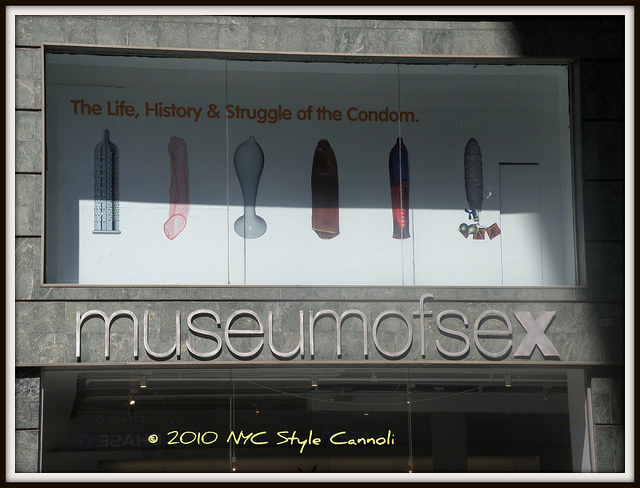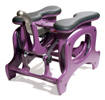Museum of Sex
 Thursday, February 3, 2011 at 8:13AM
Thursday, February 3, 2011 at 8:13AM Yes, Virginia, there is a Museum of Sex. Of course, if your name is Virginia this may not be your kind of exhibition. For exhibitionist it is, with a scholarly twist. It probably needs that for folks to wander unselfconsciously through the viewing I saw of “Sexploitation Films in the Modern Age.”
 Image courtesy of New York Style and a Little CanoliIn case you want to rush right out, the museum is located on 5th Avenue and 27th street, in the old Tenderloin district of New York City, one of the initial riper bastions in the Big Apple. It’s a fitting location for an institution devoted to the study of such delights. Wikipedia refers to the museum as “MoSex.”
Image courtesy of New York Style and a Little CanoliIn case you want to rush right out, the museum is located on 5th Avenue and 27th street, in the old Tenderloin district of New York City, one of the initial riper bastions in the Big Apple. It’s a fitting location for an institution devoted to the study of such delights. Wikipedia refers to the museum as “MoSex.”
But why, you may ask, is this institution necessary in our permissive society with porn all over the web? The museum claims to put sex in context, historically and evolutionally. It’s nice to use big words when dealing with such a basic human subject. Gets one over the smarmy feeling.
And that’s sort of how I felt when entering the museum’s first floor exhibit of sexploitation films. Should a proper woman be here? I marched in, brandishing my notebook like a badge so no one would, God forbid, think I was there to enjoy myself. And who were the rest of these people? Some were young couples holding hands (foreplay, I wondered); others on their own, one or two middle aged couples.
The sexploitation films started with very early naughty “ nudies” to the nudist films of the ‘50’s , then “cheesecake,” where breasts and backsides were okay, but the really hard stuff started in the ‘70’s. Here were clips from “Deep Throat,” and the emergence of porno stars like Marilyn Chambers. On large video screen blocks on the floor were excerpts from classics like “Debbie Does Dallas” or Peter O’Toole and Malcolm McDowell in sadistic scenes from the 1979 film “Caligula”. That still haunts me.
There was a section on the “medicalization” of sex featuring The Sinclair Institute, founded in 1991, to help couples improve their love lives, and they produced a series of graphic “how to” films also shown on large screens. I thought these “legit” educational films were some of the most salacious in the exhibit. And who could get into those positions?
 Image courtesy of Museum of SexA featured exhibit, “Rubbers,” was a rigorous romp through condoms of the ages. Ever wonder while reading gothic romance novels how the women prevented pregnancy? They tried, with prophylactics made of linen, animal intestines, fish bladders (how did they get them?), oiled paper and tortoise shells. Did they work? No info.
Image courtesy of Museum of SexA featured exhibit, “Rubbers,” was a rigorous romp through condoms of the ages. Ever wonder while reading gothic romance novels how the women prevented pregnancy? They tried, with prophylactics made of linen, animal intestines, fish bladders (how did they get them?), oiled paper and tortoise shells. Did they work? No info.
But then along came Charles Goodyear and the vulcanization of rubber in 1837 to revolutionize the devices, then latex in the 30’s and now polyurethane and even some experimental stuff.
The old packaging displays were comic: “King Kondom” with Kong holding a banana and wearing a tee shirt that said, “The great protector.” Or there was “The Shadow, “thin as a shadow, strong as an ox.” Current contenders: “Use with good judgment—Obama condom,” “McCain condom--old, but not expired.” Or, “When abortion is not an option, Palin condoms”—probably best in cold weather.
This exhibit takes us to a serious place, noting the use of condoms for disease prevention in the ‘30’s, to the present-day control of STD’s and HIV and the use and controversy surrounding such devices. The New York Times called this exhibit “fascinating.”
 Image courtesy of Museum of SexI was fascinated by a group of middle-aged women doing a guided tour. I encountered them on the museum’s second floor, which is devoted to all sorts of sexual artifacts: Life-sized dolls, a film on “The Sex Life of Robots” and “estranged sex” where women used rubber gloves. A photographic exhibit chronicled homemade sex machines. One man made a particularly vigorous device in hopes of saving his marriage. One look at the machine and you can see why she divorced him anyway. There was section on various kinks and a touchy-feely exhibit (you need to be 18 to enter the museum). The women were trying hard to be cool, but there was just something a little disconcerting about seeing a person who could be your mother perusing sexual exhibits. One of my grown daughters still prefers to think the stork brought her.
Image courtesy of Museum of SexI was fascinated by a group of middle-aged women doing a guided tour. I encountered them on the museum’s second floor, which is devoted to all sorts of sexual artifacts: Life-sized dolls, a film on “The Sex Life of Robots” and “estranged sex” where women used rubber gloves. A photographic exhibit chronicled homemade sex machines. One man made a particularly vigorous device in hopes of saving his marriage. One look at the machine and you can see why she divorced him anyway. There was section on various kinks and a touchy-feely exhibit (you need to be 18 to enter the museum). The women were trying hard to be cool, but there was just something a little disconcerting about seeing a person who could be your mother perusing sexual exhibits. One of my grown daughters still prefers to think the stork brought her.
I thought most of the exhibits were short on social context and chronological perspective. But hey, you don’t come here for a history lesson.
The museum was unprecedented when it opened in 2002. It was started by Daniel Gluck, a graduate of the Wharton School of Business and by some accounts a marketing whiz. True, sex sells, but putting it in a museum context makes it a legitimate vehicle to voyeuristically explore this whole subject for people who would never otherwise go near a tawdry sex shop. It draws 140,000 people annually.
But here’s an interesting twist: although the museum is for-profit, it’s backed by the non-profit Muse Foundation of New York, of which Mr. Gluck is a director. This has produced some juicy conflict.
 Image courtesy of Museum of SexAccording to the New York Times, a dominatrix, Mary Ann Coughlin, donated her bondage machine to the museum’s foundation, and she took a tax deduction. But this created an IRS controversy. Can you make a deductible donation to a non-profit who then turns it over to a for-profit entity where it’s displayed? The museum did not answer my query on whether this has been resolved. So if you want a deduction for your leather and handcuffs, better hold off.
Image courtesy of Museum of SexAccording to the New York Times, a dominatrix, Mary Ann Coughlin, donated her bondage machine to the museum’s foundation, and she took a tax deduction. But this created an IRS controversy. Can you make a deductible donation to a non-profit who then turns it over to a for-profit entity where it’s displayed? The museum did not answer my query on whether this has been resolved. So if you want a deduction for your leather and handcuffs, better hold off.
A cynic might ask if all this is just a come-on to justify a commercial sex show. Well, the museum says its mission is “To preserve and present the history, evolution and cultural significance of human sexuality” and to discuss such issues and their contemporary relevance. Of course, it’s all in the thigh of the beholder.
And yes, Virginia, the ground floor store is a real sex shop. There were more people in it than in the museum. It seems there’s more interest in peckeoni and titaroni shaped pasta or various erotic toys than learning about sexual mores of the times. In a society with an a double standard toward sex this attempt at studying the subject has been a long-time coming (sorry), but based on the store’s popularity, people seem to be more interested in practice than pedantry no matter how titillating. And maybe that speaks to a generational view of a real sexual revolution. Or perhaps it’s just the museum admission price of $16.75 for something you can get at home.


Reader Comments (2)
ew. who paid for this?
yes, people say they are studying, when really they are exploiting.
It’s remarkable to go to see this website and reading the views of all mates concerning this article, while I am also keen of getting know-how.